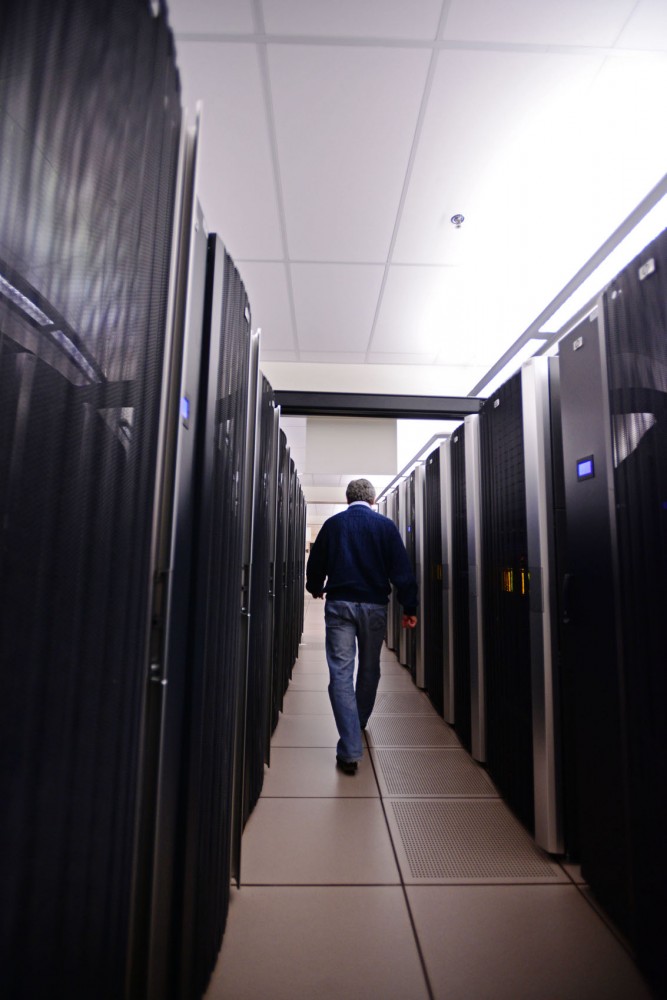Tucked away in the basement of the University of Minnesota’s Walter Library, 4,000 square feet of supercomputers flash, performing thousands of computations per second.
The Minnesota Supercomputing Institute installed a new storage system in January to keep up with the demand for big data management that researchers need. Earlier this month, the MSI announced it’s also expanding its business consulting and computing services.
Businesses can pay to use the supercomputers to process large data sets — from genetic sequences to wind turbines.
Jorge Vinals, MSI director, said the increase in business use shouldn’t interfere with the institute’s primary focus on academic research.
“Every discipline has its own motivations for using computers, has its own needs for storage,” he said. “Our job within the University
is to make sure that the money is well spent for the research that’s coming from those disciplines.”
Business use
While the neatly stacked rows of supercomputers whirred on campus, the researchers running the programs on them were tucked away in their own labs or offices all around the state.
The MSI allows researchers to connect to the computers via a remote desktop. Vinals said mostly smaller companies and startups currently use MSI’s resources, but he hopes to expand.
Lisa Herron-Olson, senior scientific director at Syntiron, said the biotechnology startup uses the computing and consulting services at MSI because it allows them to perform large-scale computations without having to buy the hardware.
“They offer all different levels of expertise and oversight depending on what you need and how familiar you are with the tools they have,” she said.
Herron-Olson said Syntiron plans to use MSI’s resources more in the future, as they have more proteins and genes to sequence for vaccine development.
If business use expands to the point that it takes away from academic research, Vinals said the MSI could buy another supercomputer with the money generated from business use.
Herron-Olson said the MSI offering businesses resources is especially helpful for startup companies because it “gives them the edge they need in order to differentiate themselves.”
Academic use
Cold water flowed through a copper pipe snaking its way around the supercomputers, keeping them at precisely 68 degrees so they didn’t overheat.
The floor at the MSI is raised to house the vast cooling and electrical networks the supercomputers require.
If the power in the building ever went out, Vinals said they have a generator with one megawatt of energy to keep the supercomputers on for 15 minutes — long enough to turn them off without losing data. Researchers run programs 24/7, he said, and a robot backs everything up nightly.
David Greenstein, genetics, cell biology and development professor, said his lab has worked with the MSI to quickly sequence entire genomes of mutant worms.
“The ability to have very fast computers that can go through this data rather quickly,” he said, “… allows us to actually pinpoint the mutants and get the molecules that are important.”
Greenstein said MSI staff members have helped his lab figure out how to handle data and put it in a form they could use.
The biggest demand from researchers is for more storage for the big data they’re acquiring from large studies and new techniques. This makes implementing new storage systems a top priority, Vinals said.
In the 1980s, he said one gigabyte of storage cost $1 million. Today, the same amount of storage costs only 10 cents.
Vinals said the supercomputing business is unique because the cost goes down while the performance continues to increase.
“It’s not so much that you want to buy the biggest or fastest machine that you possibly can,” he said. “You want to make sure that … the systems that you buy … support the best that the University has to offer.”

















